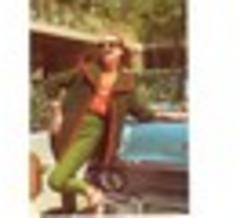 This is Kent --
This is Kent --IN 1960s Britain, knitting suddenly got dangerous.
It was already fashionable, with the post-war explosion of new yarns and bright colours satisfying the ration-weary nation's hunger for more stylish clothes.
Vogue had been producing knitting patterns since the 1930s, and colour magazines like Fashion Knits, published by yarn manufacturers Patons and Baldwins, were widely read.
Twinsets, short-sleeved jumpers with matching cardigans, had been especially popular in the 40s and 50s, with plain designs jazzed up with fancy buttons or embroidered details.
But in 1965, fashion designer Mary Quant, the woman who shocked the world with her miniskirts and hot pants, was commissioned by Wendy and Robin wools to design a range of knitted clothes. And when her thigh-length cream knitted mini-dress with knee socks and knitted bonnet became a best seller, it gave every teenage girl the chance to be outrageous.
At that time, wool shops were a common sight. In Tunbridge Wells, Jean's Wool Shop in Monson Road, The Golden Fleece in Mount Pleasant and Mrs Matthew's shop in Silverdale Road kept customers supplied with all their knitting needs, and Ayliffe's and Kathleen's were among a number which served customers in Tonbridge High Street.
"They were often run by unmarried ladies or wives whose husbands wanted them to have 'a little job', nothing too demanding, just something to get them out of the house," recalled Barry Cavie, who grew up in post-war Tunbridge Wells.
As well as drawing in top designers like Quant, whose shining asymmetric hairstyle was as recognisable as her clothes, the wool industry was also beginning to realise that links with celebrities would give their styles a more modern spin. Actress and super-model Jean Shrimpton, already a 1960s icon, was featured in a Woman's Own magazine knitting supplement in knits including a tweedy jumper with "a gay beret to match".
The woman who had shocked Australian race-goers the previous year by wearing a dress just over three inches above the knee with no stockings told readers: "When I feel like swinging, this is what I pick."
A young Roger Moore - yet to take on roles like The Saint and James Bond - also featured in a Sirdar pattern of the time, smoking a pipe and wearing a stylish zipped cardigan in pink and red.
Reflecting the new era of cheaper package holidays and wider car ownership, an early 1960s edition of Fashion Knits showed models skiing in Switzerland, gazing towards the horizon at the coast and exploring European cities like Barcelona. Designed to showcase the huge range of new yarns available, it underlined the message that anyone with a pair of knitting needles could achieve a sophisticated look.
A generation earlier, the mothers and grandmothers of the young women who snapped up these modern patterns had been patiently unpicking and re-knitting old wool garments in line with the wartime Government's instructions to "Make Do and Mend".
No-nonsense patterns were issued so that knitters could make items for servicemen and women to wear in winter, including balaclavas and gloves, in the limited range of wool available. And with fuel in short supply everywhere, home-knitted vests and socks were widely worn too.
In summer, knitted swimming costumes and trunks, notoriously disastrous when water-laden, were part of the summer holiday wardrobe.
A 1973 trade directory lists nine wool shops in Tunbridge Wells, five in Tonbridge and others scattered across local villages. But by then, with more and more mass-produced machine-knitted garments flooding the shops, the writing was already on the wall.
Home-knitting was no longer a cheaper alternative and, in any case, the girls who had worn Mary Quant in the '60s were in imported hippie-style kaftans and jeans by now. Grannies still knitted for babies, as they always had, but the craft was no longer taught at school because, in a new era, it had lost its relevance.
In the glitter and rush of the 1980s, wool shops looked increasingly dusty and old-fashioned, and many were forced to close.
If customers wanted wool, they were more likely to go to a department store than the traditional wool shop or, these days, to buy it on the internet. Reported by This is 6 days ago.